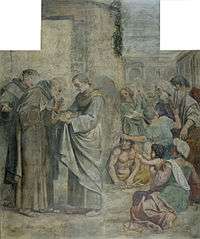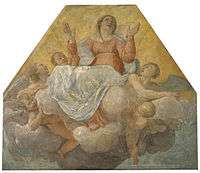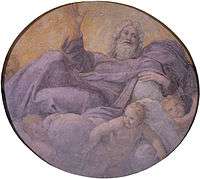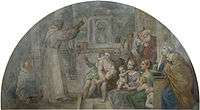Mural Paintings from the Herrera Chapel
The Mural Paintings from the Herrera Chapel is group of mural painting by Annibale Carracci and collaborators, conserved between the National Art Museum of Catalonia[1] and de Museo del Prado.
| Mural Paintings from the Herrera Chapel | |
|---|---|
 | |
| Artist | Annibale Carracci |
| Year | 1604–1606 |
| Type | Fresco transferred to canvas |
| Location | Museu Nacional d'Art de Catalunya & Museo del Prado, Barcelona & Madrid |
History
In 1602, the Spanish nobleman Juan Enriquez de Herrera dedicated a chapel in the church of Santiago, the Spanish Franciscan of Rome to Diego de Alcala, commissioning Saint Didacus of Alcalá Presenting Juan de Herrera's Son to Christ and frescoes from Carracci. The mural decoration, with scenes from the saint's life, was done by the Bolognese painter Annibale Carracci. In 1604 began designing the master of all the preparatory cartoons, but he came ill while personally directing the work 'in situ'. So, the work was finished by his collaborators, who included Giovanni Lanfranco Sisto Badalocchio and Francesco Albani. In the mid-nineteenth century the frescoes were uprooted and transferred to canvas and are now distributed between MNAC and Museo del Prado.
Description
The group consists of 16 items, 9 of which are kept at the MNAC[2] and the other 7 at the Museo del Prado in Madrid. From the former church of San Giacomo degli Spagnuoli in Rome.[3]
| # | Imatge | Title | Authors | Museum | Reference |
|---|---|---|---|---|---|
| 1 |  | Apostles around the Empty Sepulchre | Carracci i Francesco Albani | MNAC | [4] |
| 2 |  | Miracle of the Roses | Carracci, Francesco Albani i Domenico Zampieri | MNAC | [5] |
| 3 |  | Assumption of the Virgin | Carracci i Albani | MNAC | [6] |
| 4 |  | Everlasting Father | Carracci i Albani | MNAC | [7] |
| 5 |  | Healing the Man Born Blind | Carracci i Albani | MNAC | [8] |
| 6 |  | Saint Paul | Carracci & Albani | MNAC | [9] |
| 7 |  | Saint Peter | Carracci & Albani | MNAC | [10] |
| 8 |  | Predicació de Sant Dídac | Carracci & Sisto Badalocchio | MNAC | [11] |
| 9 |  | Apparition of Saint Didacus above his sepulchre- | Carraci & Sisto Badalocchio | MNAC | [12] |
| 10 |  | Apoteosi de sant Francesc | Museo del Prado | [13] | |
| 11 | Apoteosi de sant Jaume el gran | Museo del Prado | [14] | ||
| 12 | Apoteosi de sant Llorenç | Museo del Prado | [15] | ||
| 13-17 | Escenes de San Diego de Alcalá, titular de la capella | Museo del Prado | [16] |
References
- Guide of the Museu Nacional d'Art de Catalunya. MNAC, 2004. ISBN 84-8043-136-9
- The artwork at MNAC's Website
- Museo del Prado
- Apòstols al voltant del Sepulcre buit
- Miracle de les roses al web del MNAC
- Obra al web del MNAC
- Obra al web del MNAC
- Obra al web del MNAC
- Obra al web del MNAC
- Obra al web del MNAC
- Obra al web del MNAC
- Obra al web del MNAC
- P-76
- P-77
- P-78
- P-79, P-2908, P2909 i P-2910
